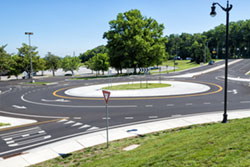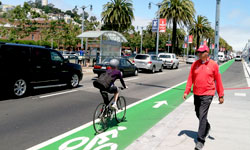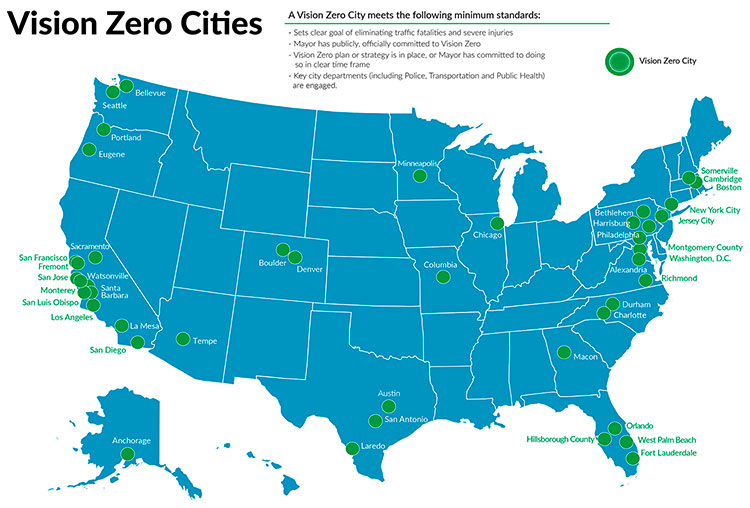What is a Safe Systems approach?
A transportation safety paradigm that fosters a holistic perspective and strives to create a transportation system that ensures no crash results in death or serious injury. Several countries have formally adopted versions of this approach, including Sweden, the Netherlands, Australia, and New Zealand. Many other transportation agencies, within and outside the United States, have applied the principles of this approach. Through CSCRS-sponsored research, we have identified several core and interconnected principles that underpin, to varying degrees, the Safe Systems approach used in different locations:
Core Principles
Example #1
Self-explaining Roads with clear visual indicators and variations prompt road user behaviors that are consistent with laws.

1. Adapting the structure and function of the system to the complexities of human behavior
A better understanding of human learning, decision-making, state awareness, and behavior in different environments (social and physical) is central to designing Safe Systems. Roadway, vehicle, and other transportation-related elements can be designed to reduce the likelihood of human mistakes, mitigate the consequences of such mistakes, and adapt to changing human behaviors.
2. Manage kinetic energy transfer among road users
Example #2
Roundabouts can help manage speeds while simplifying decision-making for drivers, reducing the likelihood of human mistakes and energy transfer.

Safer vehicle designs and roadway designs are two ways to effectively reduce the energy forces transferred in a crash between two or more road users. For example, the Dutch Safe Systems approach (‘Sustainable Safety’) emphasizes homogeneity of road user mass and/or speed, or increased separation of travel mode when this cannot be achieved. Shifting the population to safer, more sustainable methods of travel (through transit investment, pricing policies, etc.) and enforcement, automated or otherwise, are other approaches that can manage kinetic energy transfer when used appropriately.
3. Treat road user safety as the foundation of all system interventions
Example #3
Complete Streets are designed to support safe road use for all ages and road users (motorists, pedestrians, bicyclists, etc.).

Road safety travels hand-in-hand with mobility, access, equity, and other transportation values. In the U.S., we often still view safety and mobility as a tradeoff, inherently in conflict. We even structure our organizations to work separately on these issues. Places taking a Safe Systems approach have figured out how to provide multiple mobility options while ensuring safety for users of every option. These places recognize that if the safest choice isn’t the most convenient, people may not choose it, and if the most convenient choice isn’t safe for everyone, then fatalities will occur.
4. Foster the creation of a shared vision and coordinated action
Example #4
Multidisciplinary stakeholder engagement and decision-making enables different fields to coordinate efforts for road user safety.

Too often, roadway or safety decisions are made in siloed environments, with little consideration for consequences in other areas of the system. For example, a safety target may be met by one stakeholder of the road safety system, at the expense of the safety of another. There is a need for greater vertical and horizontal integration of the systems that influence safety, and a need to work holistically and proactively to prevent unintended consequences and to recognize the implications of policy making in other areas of the transportation system.
Vision Zero and Other Strategies
Sweden’s 1997 ‘Vision Zero’ strategy was one of the earliest applications of Safe Systems principles to road safety. This strategy has since been adopted by multiple countries. The strategy name sometimes varies (e.g., ‘Sustainable Safety’, ‘Towards Zero’); however, underlying the successful application of many of these strategies is a strong foundation of Safe Systems principles, with holistic change focused on zero road traffic deaths or serious injuries. In the U.S., Vision Zero has been adopted by numerous cities across the country, including Durham, Charlotte, New York City, and Seattle.

CSCRS Contributions
CSCRS activities and research continue to refine our understanding of Safe Systems and related approaches, including elements included in successful city and country applications. While many of the Center’s research projects focus on specific aspects of Safe Systems, some research projects looking at the approach broadly include: R2: An enhanced systemic approach to safety, R3: Implementing Safe Systems in the United States: Guiding principles and lessons from international practice and R17: Strengthening existing and facilitating new Vision Zero plans.
Additional Resources
- CSCRS’s Top 10 Safe System implementation pitfalls, and suggestions for how to avoid them.
- USDOT’s National Roadway Safety Strategy, released January 2022.
- ITE Talks Transportation Podcast: Transforming Transportation with Big Data.
- May issue of ITE Journal, which focused on Safe Systems.
- Washington State Strategic Highway Safety Plan 2019.
- International Transport Forum: Zero Road Deaths and Serious Injuries – Leading a Paradigm Shift to a Safe System (2016).
ITF (2016), Zero Road Deaths and Serious Injuries: Leading a Paradigm Shift to a Safe System, OECD Publishing, Paris. http://dx.doi.org/10.1787/9789282108055-en. - Belin M, Tillgren P, Vedung E. Vision Zero – a road safety policy innovation. International Journal of Injury Control and Safety Promotion. 2012; 19(2): 171-9.
- Organization for Economic Cooperation and Development (OECD). Towards zero: Ambitious Road Safety Targets and the Safe System Approach. OECD Publishing, Paris; 2008.
- Vision Zero Network (VZN). What is Vision Zero? https://visionzeronetwork.org/about/what-is-vision-zero/.
- FHWA’s “The Safe System Approach.”
- FHWA’s Winter 2022 edition of Public Roads magazine.





